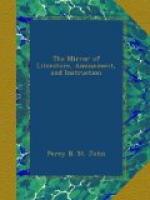* * * * *
THE STORK
Is now rarely seen in Britain; one was killed a short time since in the neighbourhood of Ethie House, and is to be seen in Mr. Mollison’s Museum, Bridge-street, Montrose. The editor of the Montrose Review believes that a stork had not been killed in Scotland since the year 1766.
* * * * *
FINE ARTS.
* * * * *
THE GRAVE OF TITIAN.
[Illustration: QVI GIACE IL GRAN TIZIANO DE VECELLI EMULATOR DE ZEUSI E DEGLI APELLI.]
Beneath this plain sepulchral stone, in the church of Santa Maria de Frari, at Venice—rest the ashes of TITIAN, the prince of the Venetian school of painters, and who, “was worthy of being waited upon by Caesar.” Yes, this alone denotes his grave at the foot dell’Altare di Crocisfisso.
Titian was born at a sequestered town in the Alps of Friuli, in the year 1477, his father being of the ancient family of Vecelli. He began very early to show a turn for drawing, and designed a figure of the Virgin, with the juice of flowers, the only colours probably within his reach. He was the scholar of Giovanni Bellino, but adopted the manner of Giorgione so successfully, that to several portraits their respective claims could not be ascertained. The Duke of Ferrara was so attached to Titian, that he frequently invited him to accompany him in his barge from Venice to Ferrara. At the latter place he became acquainted with Ariosto. In 1647, at the invitation of Charles V. Titian joined the imperial court. The emperor then advanced in years sat to him for the third time. During the time of sitting, Titian happened to drop one of his pencils, the emperor took it up; and on the artist expressing how unworthy he was of such an honour, Charles replied, “that Titian was worthy of being waited upon by Caesar.” But, “to reckon up the protectors and friends of Titian, would be to name nearly all the persons of the age, to whom rank, talent, and exalted character, appertained. Being full of years and honours, he fell a victim to the plague in 1576, at the age of ninety-nine. To perpetuate his memory, the artists at Venice proposed celebrating his obsequies, with great pomp and magnificence in the church of St. Luke, the programme of which is given at length, by Ridolfi; but, owing to the prevalence of the plague, no funeral ceremony was allowed by the state: the authorities, however, made an exception in Titian’s favour, and suffered him to be buried in the church of Friari, as we have stated.”




